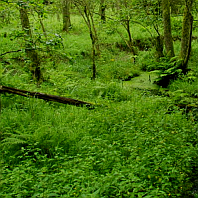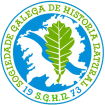Now that the third conference of the Week of Land Stewardship in As Mariñas of A Coruña and the River Mandeo Area is over, it is timely to take stock.
The opening day on the 20th was fully satisfactory. The speakers were able to woo the audience and, considering that the talks were so specialized, we consider the audience of 55 people a success.
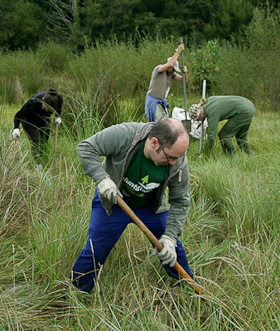 The following day 18 volunteers went to Alameda beach, in Ponte do Porco (Miño). With that day’s work and the review carried out subsequently, they succeeded in eliminating the Pampas grass (Cortaderia selloana), the Canadian horseweed (Conyza canadensis) and the ice plant (Carpobrotus edulis). Although we had already eradicated it in 2011, a small branch had taken root, possibly brought in by the tide.
The following day 18 volunteers went to Alameda beach, in Ponte do Porco (Miño). With that day’s work and the review carried out subsequently, they succeeded in eliminating the Pampas grass (Cortaderia selloana), the Canadian horseweed (Conyza canadensis) and the ice plant (Carpobrotus edulis). Although we had already eradicated it in 2011, a small branch had taken root, possibly brought in by the tide.
There were four sacks type big-bag full of vegetal waste from invasive exotic species. Moreover, there were also two sacks full of litter, plus four piles of fishing gear and ropes from bateas (rafts for mussel cultivation), which were not put into the sacks because of their weight and volume. Therefore, mission accomplished.
But there was a surprise.
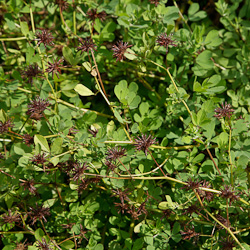 We were intrigued by a shrub that grows on the beach because it does not appear in the Galicia flora guides, and there was a single specimen. Should it have been a new invasive species, it was the moment to eliminate it.
We were intrigued by a shrub that grows on the beach because it does not appear in the Galicia flora guides, and there was a single specimen. Should it have been a new invasive species, it was the moment to eliminate it.
As a precaution, we asked Dr Elvira Sahuquillo, from the University of A Coruña, to confirm the plant’s identity. It turned out to be a native species of the Iberian Peninsula, the Dorycnium rectum. It has several names in Spanish, among them carretón bravo or emborrachacabras. It is found in the Mediterranean regions, living in reed beds and meadows close to watercourses, mainly on basic substrates. It is rare in Galicia, having only been cited in Lugo and Pontevedra.
Since it is the first time that it has been found in the province of A Coruña, we botanized some small branches and sent them to the SANT Herbarium of the University of Santiago de Compostela. It is headed by Dr Javier Amigo, who had given a speech on the flora and habitats of our area on the opening day of the conference.
Dr Jaime Fagúndez, of the University of A Coruña, gave a lecture titled The threat of exotic invasive species in As Mariñas. Addressing an audience of 36 people, he made known those species present in our area and emphasized the huge problem they entail if we remain indifferent to this problem.
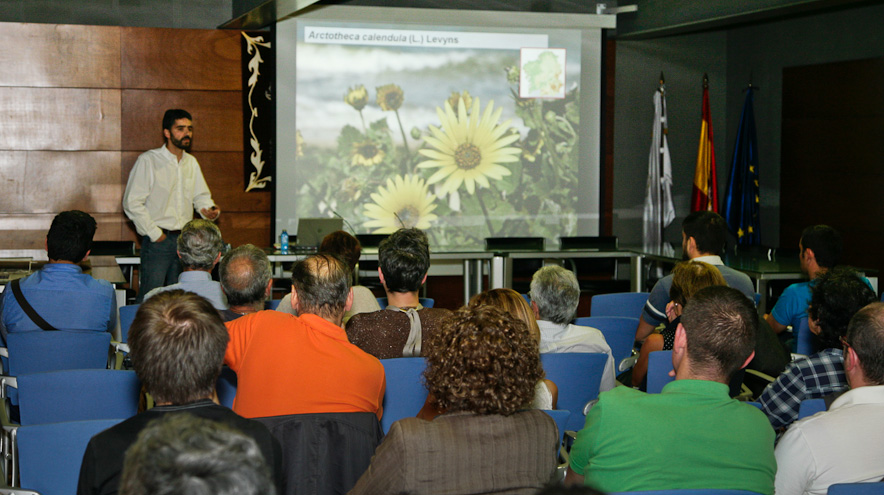
Saturday the 27th in the afternoon was the most complicated day. It was the first time that we had organized the eco-regatta. After a slight delay at the start, five boats with their corresponding teams ―identified by scarves of different colours― left for the reed bed sectors that had been earmarked for clear-up. The boats had to make several trips back to the dock, and little by little the mountain of garbage grew on the dock.
The eco-regatta finished before scheduled, because we ran out of sacks: we had purchased 200, thinking that they were more than enough! They were filled with bottles, plastics and all kind of litter, plus two fridges, one freezer and one television. A truck tyre and an abandoned zodiac boat full of litter were also towed away.
After spending the afternoon playing and collecting garbage at the dock, a group of children formed the jury. They awarded the first prize, a cod pie, to the team that presented the television set, and meat and tuna pies to the finalists. The 33 participant volunteers shared these symbolic prizes while they chatted about the day.
The 21 participants in the simultaneous cleaning of the Galician rivers ―among them six children― picked up 28 sacks of litter and one toilet bowl. In the stretch of river that was covered, from Os Cabalos Bridge up to the A Ermida Bridge, we found not too much litter, because we had already cleaned it last year; this proves that when an area is cleaned, the results can still be noticed in subsequent years. Most of the litter was picked up at the foot of the bridges, where illegal landfills are formed.
Fragas Mandeo considers the balance really positive: a new species for the province, three invasive species eradicated from Alameda beach, 163 participants and approximately 25 cubic meters of waste less in the environment. Thus, we thank speakers, participants and volunteers for their participation, as well as collaborating municipalities and entities.

